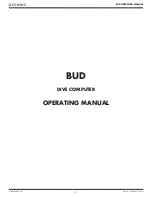
7-12
IM WT310E-02EN
7.4.5 Harmonic Measurement (/G5 Option)
Item
Specifications
Measured item
All installed elements
Method
PLL synchronization method
Frequency range
Fundamental frequency of the PLL source is in the range of 10 Hz to 1.2 kHz.
PLL source
• Select voltage or current of each input element.
• Input level
50% or more of the rated measurement range when the crest factor is 3.
100% or more of the rated measurement range when the crest factor is 6 or 6A.
• The frequency filter must be turned on when the fundamental frequency is less than or equal to 200Hz.
FFT data length
1024
Window function
Rectangular
Sample rate, window width, and upper limit of harmonic analysis
Fundamental Frequency
Sample Rate
Window Width Upper Limit of Harmonic Analysis*
10 Hz to 75 Hz
f×1024
1
50
75 Hz to 150 Hz
f×512
2
32
150 Hz to 300 Hz
f×256
4
16
300 Hz to 600 Hz
f×128
8
8
600 Hz to 1200 Hz
f×64
16
4
f in the equation is the input fundamental frequency.
* The upper limit of harmonic order can be decreased.
Accuracy
(The accuracy shown below is the sum of reading and range errors.)
When Line Filter is OFF
<WT310E/WT332E/WT333E>
Frequency
Voltage
Current
Power
10 Hz ≤ f < 45 Hz
0.15% of reading
+0.35% of range
0.15% of reading
+0.35% of range
0.35% of reading
+0.50% of range
45 Hz ≤ f ≤ 440 Hz
0.15% of reading
+0.35% of range
0.15% of reading
+0.35% of range
0.25% of reading
+0.50% of range
440 Hz < f ≤ 1 kHz
0.20% of reading
+0.35% of range
0.20% of reading
+0.35% of range
0.40% of reading
+0.50% of range
1 kHz < f ≤ 2.5 kHz
0.80%+ of reading
+0.45% of range
0.80%+ of reading
+0.45% of range
1.56% of reading
+0.60% of range
2.5 kHz < f ≤ 5 kHz
3.05% of reading
+0.45% of range
3.05% of reading
+0.45% of range
5.77% of reading
+0.60% of range
<WT310EH>
Frequency
Voltage
Current
Power
10 Hz ≤ f < 45 Hz
0.15% of reading
+0.35% of range
0.15% of reading
+0.35% of range
0.35% of reading
+0.50% of range
45 Hz ≤ f ≤ 440 Hz
0.15% of reading
+0.35% of range
0.15% of reading
+0.35% of range
0.25% of reading
+0.50% of range
440 Hz < f ≤ 1 kHz
0.20% of reading
+0.35% of range
0.20% of reading
+0.35% of range
0.40% of reading
+0.50% of range
1 kHz < f ≤ 2.5 kHz
0.80%+ of reading
+0.45% of range
0.95%+ of reading
+0.45% of range
1.68% of reading
+0.60% of range
2.5 kHz < f ≤ 5 kHz
3.05% of reading
+0.45% of range
3.35% of reading
+0.45% of range
6.05% of reading
+0.60% of range
• When the crest factor is set to 3.
• When λ (the power factor) is 1.
• Power figures that exceed 1.2 kHz are reference values.
• For a direct current range, add 10 μA to the current accuracy and (10 μv/direct current range) × 100% of range to the power
accuracy.
• For the external current sensor range, add 100 μA to the current accuracy and (100 μV/external current sensor range rating) ×
100% of range to the power accuracy.
• For nth harmonic component input, add ({n/(m + 1)}/50)% of (the nth harmonic reading) to the n + mth harmonic and n – mth
harmonic of the voltage and current, and add ({n/(m + 1)}/25)% of (the nth harmonic reading) to the n + mth harmonic and n –
mth harmonic of the power.
• Add (n/500)% of reading to the nth component of the voltage and current, and add (n/250)% of reading to the nth component
of the power.
• The accuracy when the crest factor is 6 or 6A is the same as the accuracy when the crest factor is 3 after doubling the
measurement range.
• The guaranteed accuracy ranges for frequency, voltage, and current, are the same as the guaranteed ranges for ordinary
measurement. If the amplitude of the high frequency component is large, influence of approximately 1% may appear in certain
harmonics. Because the influence depends on the size of the frequency component, if the frequency component is small with
respect to the range rating, the influence is also negligible.
7.4 Features












































